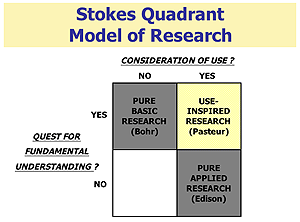|
|
You never heard of that, right? What do you hear about Louis Pasteur? That he pasteurized the milk of France and the wine industry of France, right? Well, that was the middle[-aged] Louis Pasteur. So this question is often raised: Was Louis Pasteur a pure or an applied researcher? This question was addressed in a book that came out about 10 years ago and is becoming an underground cult item among some people who are involved in research administration and try to set research agendas. The 1997 book by Donald Stokes [Pasteur’s Quadrant: Basic Science and Technological Innovation] explored this question—whether Louis Pasteur was a pure or applied researcher—and showed that, in fact, he was both. It’s a slightly different model, however. [Stokes] really called into question (and this is why it's become a cult book over the last decade) the fundamental analysis of Vannevar Bush from the end of the Second World War, which has driven scientific growth since that time. The takeaway message was this: that the one-dimensional world of Vannevar Bush (remember, it went from curiosity-driven research to applied research to technology development to product) was really a two-dimensional world.
So, how is it a two-dimensional world? The two axes are, first of all, a consideration of use; what you're looking at is driven by what the ultimate use is going to be. The second axis is a quest for fundamental understanding, discovery of fundamental knowledge. Now, if you think of it in this two-dimensional way, then in a simple binary world, you can have four possibilities for this.
First of all, is there a quest for fundamental understanding? Yes. Is there a consideration of use? No. That's the classic example of curiosity-driven research, and one of the prime examples in the book is Niels Bohr, who, looking at the structure of the atom in one of the first models, completes models of the atom and the generation of quantum mechanics. He didn't care how the atoms were used. He didn't care about the concept of what ultimately became nuclear energy or anything like that. All he cared about, fundamentally, was what the structure of the atom was and whether he could describe certain optical phenomena from this.
>
01 02 03 04 05 06 07 08 09 10 11 12 13 14 15 16 17 18 19
|
|

|
